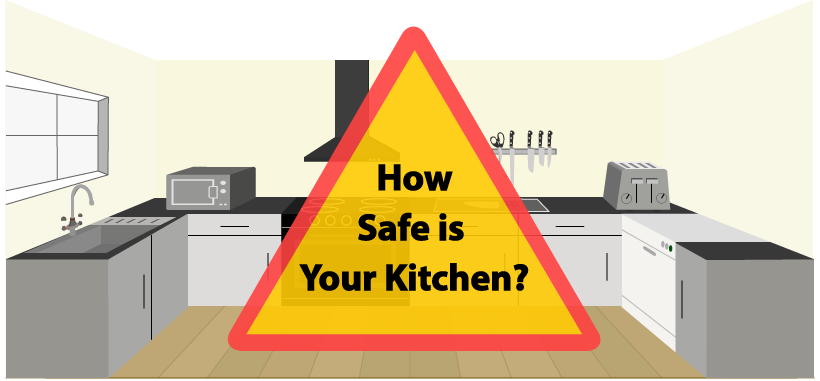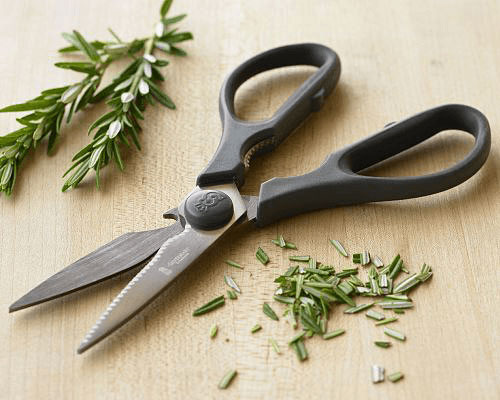How Safe is Your Kitchen? A Definitive Guide Discovering The Dangers

7 Tips on Choosing the Right Pair of Hair Cutting Scissors
October 7, 2016
How to Start a Hair Salon?
September 17, 2019How Safe is Your Kitchen? A Definitive Guide Discovering The Dangers
Download our PDF guide![]() here.
here.
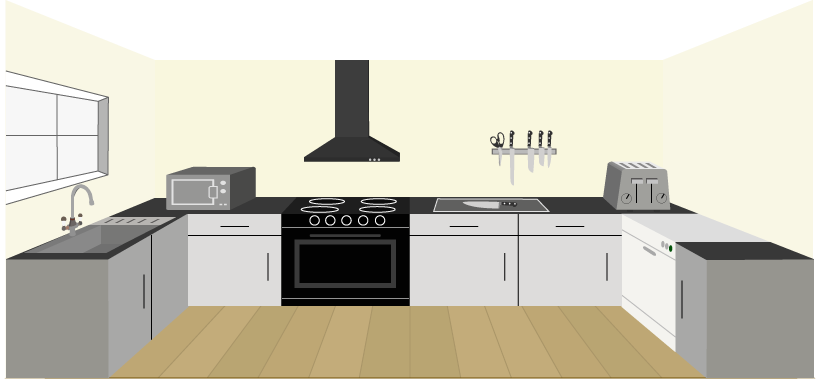
Injuries in the kitchen can do as little as ruin a great dinner to do as much as take you to A&E for the night. We’ve all experienced a few minor cuts here and there, but are there hidden dangers in your kitchen which you may be unaware of?
More accidents happen at home than anywhere else and these accidents result in approximately 6000 deaths each year. There are multiple reasons for these accidents such as falls, accidental poisoning, fires and cuts and a lot of these occur in the kitchen.
There are a number of ways in which you can injure yourself in your own home, you may believe your house is relatively safe but with one spillage or moment of forgetfulness, things could end fatally.
When it comes to house fire statistics, the kitchen is the most dangerous room in the house – causing 62% of all accidental house fires in 2013/14. However, the kitchen can pose even more harmful threats to you than just fires. You could also slip and bruise yourself (or worse), cut yourself while preparing food or washing up, and be involved in many other accidents if you are not careful.
In this guide, we will be discussing the most common appliances within your home that could possibly lead to casualties and even fatalities. You’ll discover the types of accidents that can be caused by these appliances, how to avoid them and what to do if they do happen to you.
Gas Cooker
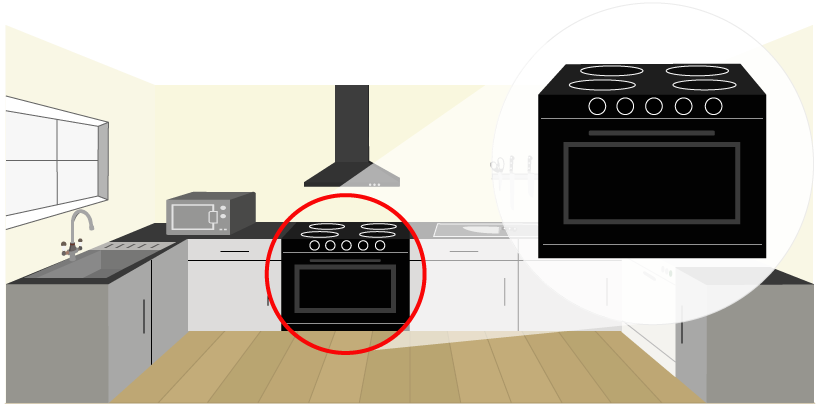
We’ve all experienced an accidental burn from touching the pan whilst cooking, or have been spat at by oil because of the hob being turned up too high. We’ve probably all experienced the minor burns and accidents related to cooking, but what about the more consequential accidents?
Reasons For Accidents
Burns
Scraping a hot pan with your finger may not seem like the end of the world – run it under cold water and be done with it, right? When you’re lucky enough to just burn your finger, this is probably the correct way to go about it, but a lot of the time it is more than just a burnt fingertip.
Simply forgetting to put your oven gloves on can result in serious damage to your hands as well as other parts of your body. Not wearing the correct protection could result in you pouring boiling water over your whole body and/or scalding your hands, a limb, or worse.
Burns like this cannot be fixed with cold water, they need to be more thoroughly treated.
The Hob
Even at a young age you learn how to use the hob and frying pan to cook simple foods like egg and bacon, but what are the dangers with this appliance?
Whenever heat is present, there will always be dangers that follow. One of the main dangers of cooking on a gas hob is the extreme temperatures that oil and water can get to, these heats can result in a number of unpleasant scenarios.
If your cooker is exerting too much heat when cooking items like pasta, the water will overflow down the sides of the pot and spread across the base of the hob. Within seconds, your boiling water can put out the flame leaving unlit gas to pump into the air of your home.
Frying common items like egg and bacon can, unfortunately, also end badly. Oil reaches its boiling point at a much later stage than water (water = 100°C, oil = 300°C) which means it can climb to much higher temperatures when cooking. At such scorching temperatures, oil can begin to ‘spit’ and this is where the dangers are introduced.
If this spitting oil makes contact with your skin, you could be left with extremely painful burns. On top of this, the oil can travel anywhere – it could hit your arm, hand or even your eye – if your eye is struck you could potentially lose part of your vision.
Oven Fires
Kitchen fires account for over half of accidental domestic fires in the UK, around 70% of these fires are related to cooking. There are multiple reasons why these statistics are so high and hopefully being aware of them can help bring them down.
It’s common to turn the cooker on, insert the items you wish to cook and leave it until it’s time to take it out. This can cause all kinds of problems. Firstly, if you accidentally turn the heat up too high, you will burn your food which can sometimes produce lots of smoke. This smoke is difficult to remove and (depending on the density) has the potential to suffocate you if it’s not dealt with quickly.
Secondly, a lack of monitoring can easily result in a kitchen fire. Although the initial oven fire may begin because of a different cause, the fire could spread across the kitchen and possibly the whole house if you are not there to stop it early. This is why monitoring the cooker at all times is essential.
Oven fires can start for a number of reasons, but a dirty oven is the main culprit. Demographically, students have the highest chance of causing a fire from a dirty oven, this is because they’re the least likely to clean them. If you do not clean your oven, however, then baked-on foods will eventually get stuck to it. This is not a problem when the oven isn’t in use (in terms of fires) but when it is on, a mixture of high temperatures and the build-up of this food and grease can cause odd smells, smoke and even fire.
Gas Cooker Safety Tips
![]() Cook on a lower heat.
Cook on a lower heat.
![]() Clean the oven every 3 – 12 months depending on usage.
Clean the oven every 3 – 12 months depending on usage.
![]() Don’t leave food unattended.
Don’t leave food unattended.
![]() Cover up food that might spit.
Cover up food that might spit.
![]() Make sure your oven is working by getting it professionally checked out.
Make sure your oven is working by getting it professionally checked out.
What to Do in The Event of a Fire
Close the oven door – starve it from oxygen.
Fires need oxygen to stay alive, so the first thing you should do (after turning the gas off) is shut the oven door. This will be an attempt to starve the fire from oxygen which could be the safest way of putting it out.
If it goes out, open your windows.
If the fire does go out, the next thing you should do is open the oven door and remove the tray/pan that is now extremely burnt. After this, open all the outside doors and windows in your kitchen to remove the smoke as quickly as possible. Keep all other doors shut, preventing the smoke from travelling through the rest of your house.
Leave the house and phone the fire brigade.
If the fire does spread beyond the oven and you do not have a kitchen fire extinguisher, leave the house and phone the fire brigade. This is the safest option for you as fires can spread and can become extremely dangerous very quickly.
Determine the cause of the fire before cooking again.
Finally, before you use your cooker again, you need to determine the cause of the fire and fix it. Otherwise, the same problem could occur again.
Toaster
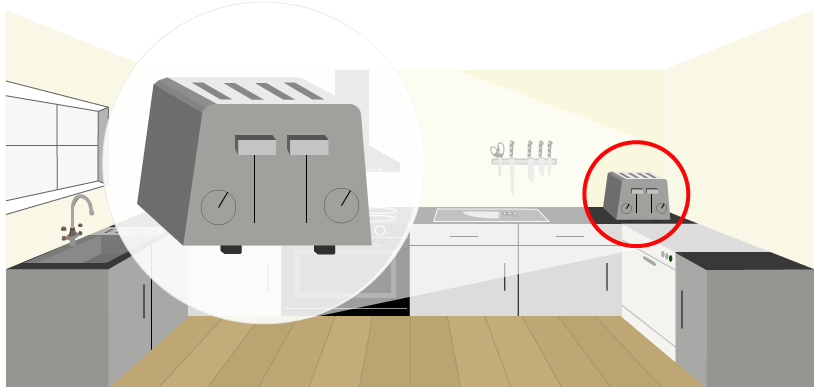
The toaster is an appliance you probably use every day for your breakfast or lunch, but did you know it can kill? Yes, without taking the right precautions you could be a victim of a toaster death. So, how can your toaster be so deadly?
Reasons for Accidents
Fishing for Toast
It’s not uncommon to find your toast stuck in the toaster – maybe it’s too small to pop up or has stuck to something whilst cooking. Regardless of what item of toasted food is stuck in your toaster or how it got there, it’s what we do about it that can end in injury.
It’s annoying when your toast gets stuck and the quick solution is to just reach in and grab it, this is the easiest way to burn yourself. Although it may be the quickest solution, it is far from the smartest and you could end up with a nasty burn or two from it.
The only thing worse than reaching in and grabbing toast with your hands is doing it with a metal piece of cutlery. Sometimes it is just too deep to reach with your hands, when this happens it is extremely tempting to try and fish it out with a knife or fork. Over 700 people die each year from toasters and this is one of the main reasons why. If any metal contacts the inside of your toaster whilst it’s on – and whilst you’re holding the metal – you could receive a fatal electric shock.
Electrical Faults
Statistically, toasters actually kill more people per year than sharks do. They require a large amount of electricity to work effectively and this current can become fatal. Operating your toaster with wet fingers, near a sink or near any other wet environment is very dangerous and is the reason for many toaster deaths. As water is a very good conductor of electricity, it only takes a small connection for a live current to successfully pass through it onto your body.
Fire
Fires can be caused from toasters, too. After a long period of time crumbs will accumulate at the bottom of the toaster, if you do not clean it on a regular basis this could become a fire hazard. The electrical current generated from the toaster can heat up the excess crumbs in it which could result in them catching fire.
As well as this, leaving an item of food cooking for too long could also result in smoking and eventually catching fire.
Toaster Safety tips
![]() Unplug the toaster when it’s not in use.
Unplug the toaster when it’s not in use.
![]() Always monitor the toaster when it is in use – never leave it unattended.
Always monitor the toaster when it is in use – never leave it unattended.
![]() Regularly clean the toaster – crumbs are one of the main reasons why they catch fire.
Regularly clean the toaster – crumbs are one of the main reasons why they catch fire.
![]() Check how long the timer is set for and the heat setting.
Check how long the timer is set for and the heat setting.
![]() Never reach into a toaster with a metal fork or knife.
Never reach into a toaster with a metal fork or knife.
![]() Never operate a toaster near water.
Never operate a toaster near water.
What to Do if a Toaster Sets Fire
Use a fire extinguisher or heavy blanket/towel.
If it does catch fire, don’t use water to put it out as this could cause more harm than good. As stated previously, water is a very good conductor so throwing it over an electrical appliance could make the fire worse or electrocute you. Instead, use a fire extinguisher if you have one or a heavy towel or blanket to cover the fire.
Disconnect from the power source (mains electricity).
If you can safely disconnect the toaster from its power source, then do so. This will ensure no more electricity will run through the toaster and will also prevent the fire from reoccurring until the problem is fixed.
If the fire spreads, then call the fire brigade and get out of the house.
If the fire grows too much to safely put out, then remove yourself from the house and call the fire brigade. It is always better to be safe than sorry so don’t take any unnecessary risks.
Sharp Objects (knives, scissors)
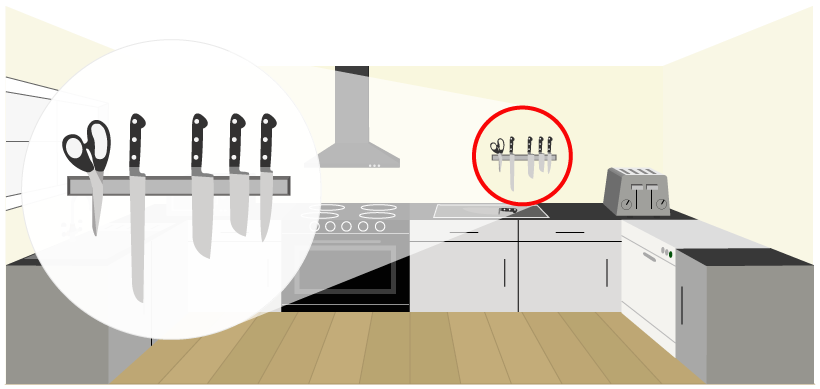
Kitchens are typically used for meal preparation, cooking and washing up. All three of these processes require certain appliances and equipment. Meal preparation – which is probably the biggest connotation of the word “kitchen” – requires sharp objects like knives and scissors, for example.
These objects are quite obviously harmful if used incorrectly; there are approximately 1200 knife related injuries treated by emergency departments in the US every day. We’ve all probably experienced a few small cuts here and there, but these small incidents could easily become something more consequential without a wider knowledge of the dangers.
Reasons For Accidents
Cuts
Once you’re finished using cutlery like spoons, knives and forks, it is common to put them in the sink or a bucket of soapy water to soak. Doing this with sharp knives and scissors, however, can result in some rather nasty gashes. The problem with soapy water is you cannot see through it; this means you don’t know what your hand is actually reaching for. Furthermore, it only takes one wrong move to brush past a sharp blade within the soapy water and cut yourself.
Catching a Falling Blade
In general, the first thing you do when you knock something over is attempt to catch it, that’s just the way the human body works. This is why catching a falling pair of scissors is more common than you might expect and obviously, grasping a such a sharp blade can result in severe injury that may need treatment.
If you don’t react quick enough to catch the falling pair of scissors, you then may be in danger of the blade landing on your foot or cutting another part of your body. Cutting your foot (or even a limb) from a falling pair of scissors can be just as painful, if not worse, as catching one.
Blunt Blades
Contrary to popular belief, you have a higher chance of receiving an injury from a blunt blade than a sharp one. This surprising fact comes with its reasons, though.
The main difference between a sharp knife and a blunt knife is how easily they can cut through certain foods and objects. The sharper the knife, the easier the cut. Because of this, you have to exert more force into a blunter knife to create the same results as a sharp one would. This extra force used can become uncontrolled and therefore can result in the knife slipping due to its bluntness (instead of cutting through the food/object like a sharp knife would), this could ultimately end up slicing or stabbing you.
As well as exerting more force with every cut, you will usually have to make more actual cuts with a blunter knife to obtain the same results as a sharp knife – a sharper knife would require far less energy to be effective. Moreover, due to the law of probability, there’s more chance of you cutting yourself with a blunt knife as you will be using it more frequently.
Improper Cutting Method
Another main reason for accidental knife injuries is the way in which a person actually cuts something. By incorrectly holding a knife, you are putting yourself in immediate danger and are increasing the chances of accidentally cutting yourself. Similarly, the object or food you plan to cut needs to be placed correctly, too.
94% of recorded accidental knife injuries are lacerations, one of the main reasons behind this is the way in which we choose to cut objects and food. When the cutting board is missing, it is very tempting to just quickly hold the object in your hand and cut through it. This is one of the easiest ways to cut yourself – it is not steady, not controlled and something can very quickly go wrong if you are not extremely careful.
Others may not hold the object when a cutting board isn’t present, but may place it on an unstable or slippery surface instead. This is just as dangerous as holding an object whilst cutting, all it takes is one slip and the knife could end up slicing your hand or even stabbing you.
Safety Tips For Sharp Objects
![]() Sharpen your knives.
Sharpen your knives.
![]() Don’t hold food in your hand when cutting it.
Don’t hold food in your hand when cutting it.
![]() Cut on a secure cutting board – never slice things freehand on unstable surfaces.
Cut on a secure cutting board – never slice things freehand on unstable surfaces.
![]() Hold the knife correctly.
Hold the knife correctly.
![]() Never try to catch a falling pair of scissors or knife.
Never try to catch a falling pair of scissors or knife.
![]() Wash knives and scissors immediately after use instead of leaving them in soapy water.
Wash knives and scissors immediately after use instead of leaving them in soapy water.
What to Do in The Event of an Injury
Wash the cut and apply pressure to stop the bleeding.
If you do cut yourself, the first thing you need to do is clean the wound. This will reduce the chances of the cut getting infected. Once the cut is cleaned, apply pressure so the bleeding is minimal.
If the cut is more severe (squirting blood or amputation), call the ambulance or get to A&E.
If your cut is producing anything more than just oozing blood, for example squirting blood or even amputation, then you need to call the ambulance or get to A&E as soon as possible. Still apply pressure to the wound to reduce the bleeding, but definitely make your way to A&E as quick as you can.
Bandage/plaster up. If you need to prepare food, then put on gloves.
If you still need to prepare food after you’ve cut yourself, always remember to put a plaster or bandage on the cut, this is so your blood cannot make its way into the food. To be extra sure, it is advisable to wear gloves.
Dishwasher

The friendly household dish washer is used to aid you with washing up and make your life much simpler, but can it actually be deadly? Without the right care and consideration for this machine, you house could quite possibly end up in flames.
Reasons For Accidents
Fires
In England, 36% of accidental dwelling fires in 2014/15 were caused by misuse of equipment or appliances. There are many different ways to misuse electrical appliances like dishwashers – simply over-stacking it, for example, can lead to tragic consequences.
To function properly, dishwashers require both water and electricity. As we know, these two elements have the potential to cause catastrophic damage when they collide. This is why so many fires can start from this appliance.
One of the most common ways a dishwasher can catch fire is through moisture contacting the wires. As soon as moisture finds its way to the wires, they can ignite within seconds and spread even quicker. Similarly, any leaking components can create a similar problem due to the leaking fluid making its way to the dishwasher’s power source or other electrical appliances.
Slips
Although being a fire hazard is the dishwasher’s main downfall, it can also be dangerous in other ways.
Stacking the dishwasher is a tedious task and the majority of us just want it done as quick as possible, because of this we can make mistakes that are easily avoidable. Stacking knives with the blade up, for example, is a recipe for disaster. The kitchen floor can become very slippery at times and a slippery floor plus upwards facing knives can only end badly.
It has been recorded that a number of deaths have occurred by children and adults slipping onto an open dishwasher and landing on upward facing knives. Some cases lead to minor cuts or bruises but others have led to punctured lungs and even deaths.
Dishwasher Safety Tips
![]() Always stack the dishwasher with sharp objects facing down.
Always stack the dishwasher with sharp objects facing down.
![]() Don’t leave the dishwasher door open.
Don’t leave the dishwasher door open.
![]() Watch out for children running around.
Watch out for children running around.
![]() Check your dishwasher at least once a year to discover leaks and other problems.
Check your dishwasher at least once a year to discover leaks and other problems.
![]() Always supervise the dishwasher when it’s in operation – don’t leave it running if you aren’t present.
Always supervise the dishwasher when it’s in operation – don’t leave it running if you aren’t present.
![]() Make sure the dishwasher’s power source is plugged into a grounded socket instead of an extension lead.
Make sure the dishwasher’s power source is plugged into a grounded socket instead of an extension lead.
What to Do in The Event of an Accident
Use a fire extinguisher or heavy blanket/towel.
If it does catch fire, don’t use water to put it out as this could cause more harm than good. As stated previously, water is a very good conductor so throwing it over an electrical appliance could make the fire worse or electrocute you. Instead, use a fire extinguisher if you have one or a heavy towel or blanket to cover the fire.
If the fire spreads, then call the fire brigade and get out of the house.
If the fire grows too much to safely put out, then remove yourself from the house and call the fire brigade. It is always better to be safe than sorry so don’t take any unnecessary risks.
Treat the wound or get to A&E.
If you slip and injure yourself, treat the wound with appropriate bandaging and dressing. If the injury is beyond domestic treatment, you need to get to A&E as soon as possible – call an ambulance depending on the severity.
Microwave Oven
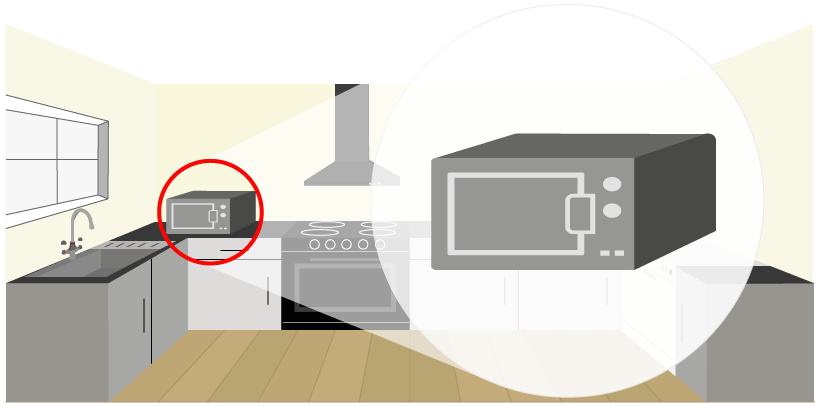
Microwaves are a highly versatile kitchen appliance. They have the ability to defrost, re-heat and cook foods and beverages. This is simply done through the use of multiple high frequency electromagnetic waves which vibrate the liquid molecules inside your food and drink.
Reasons for Accidents
Microwaving Metal
The inside of microwave ovens are coated in metal sheets. This is because the electromagnetic waves, produced by a magnetron inside the microwave, reflect off of them to ensure all the waves end up getting absorbed by the food inside.
Therefore, adding more metal to the middle of the oven would mean the waves will not get absorbed and instead get reflected. Furthermore, the waves will then bounce around the oven and attempt to heat up everything they come into contact with. Ultimately, this will results in the microwave overheating, producing sparks within the oven and potentially catching fire.
Similarly, turning your microwave on with nothing inside will pose a similar threat. This is because the electromagnetic waves will begin to bounce around the oven but have nothing to be absorbed by, resulting in the microwave to effectively self-destruct.
Electrical Faults
Positioning a microwave incorrectly could also be very dangerous. Just like any other electrical appliance, it is extremely unsafe to operate a microwave near water as this can easily turn into a fire hazard.
Any electrical fault with a microwave can be unsafe because the machine requires a large amount of energy to work effectively, this means any loose wires have the potential to cause a fire if they come into contact with water or any other flammable items.
Electrical faults can happen without you even knowing it. You may ask yourself, how? But as soon as you leave the room whilst your microwave is in operation, you are risking any electrical fault turning into a house fire. Even leaving the room for 2 minutes is enough time for a fire to start and spread across your kitchen.
Microwave Oven Safety Tips
![]() Always monitor the microwave when it’s on.
Always monitor the microwave when it’s on.
![]() Never leave the room when it is on as you could cook something for too long.
Never leave the room when it is on as you could cook something for too long.
![]() Plug into mains instead of extension lead.
Plug into mains instead of extension lead.
![]() Check what you’re putting in the microwave before you put it in.
Check what you’re putting in the microwave before you put it in.
![]() Never turn the microwave on whilst it is empty – the magnetron will absorb its own waves and self-destruct.
Never turn the microwave on whilst it is empty – the magnetron will absorb its own waves and self-destruct.
What to Do in The Event of an Accident
Switch the mains plug off.
If your microwave blows up from metal, make sure to turn it off from the mains and remove it from the vicinity as soon as it becomes possible.
Put out the fire with a fire extinguisher or heavy blanket/towel.
If a fire starts from putting metal in the microwave, or you accidentally turned it on whilst it was empty, you need to put it out before it spreads with a fire extinguisher or heavy blanket/towel. Don’t use water as this could help the fire grow instead of putting it out.
Leave the house and call the fire brigade.
If the fire does spread and it’s unmanageable, then get out of the house and call the fire brigade to reduce the risk of causing yourself any harm.
Conclusion
The kitchen is one of the busiest rooms in a house, it is the focal point of a home where people cook meals, eat together and entertain one another. When you think of the kitchen, you think of all the good things that happen inside it, but do not forget about the hazards and dangers that also live inside the kitchen.
In this post, we have discussed the main dangers within the kitchen but have also discovered ways in which these dangers can be avoided. Hopefully, after reading this guide, you are aware of the main hazards in the kitchen but can confidently stop them from amounting to anything more.
Of course, the threats which have been discussed in this guide are not the only threats within your kitchen, there are other ways in which your kitchen can be harmful. But, as long as you’re careful and aware when preparing meals, cooking, cleaning and anything else you may be doing in the kitchen, you have absolutely nothing to worry about.
Download our PDF guide![]() here.
here.

